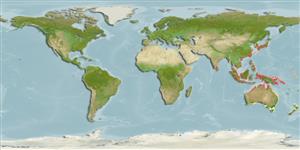Environment: milieu / climate zone / نطاق العمق / distribution range
البيئة
بحري مرتبطة بالشعاب; نطاق العمق 5 - 20 m (Ref. 90102). Tropical
Indo-West Pacific: India east to Sagami Bay, Japan and China. A new record was reported from southern Indonesia (Ref. 5978).
الحجم / وزن / العمر
النضج: Lm ? range ? - ? cm
Max length : 14.0 cm TL ذكر/ مختلط الجنس; (Ref. 559)
الأشواك الظهرية (المجموع) : 10; الأشعة الظهرية الناعمة (المجموع) : 12; شوكة شرجية: 3; أشعه شرجية لينه: 6. Distinguished from C. aprinus by the bright yellow coloration when viewed underwater (Ref. 48636).
Body shape (shape guide): short and / or deep; Cross section: compressed.
Occurs on rocky cliffs in deep water (Ref. 9710). Also inhabits muddy substrates in protected bays where wave action has no influence (Ref. 48636). Solitary (Ref 90102).
Life cycle and mating behavior
النضج | التكاثر | وضع البيض | بيض | الخصوبة | Larvae
Bi-directional sex change has been confirmed for this species (Ref. 103751). Sexual pattern seem to be intermediate between simultaneous and sequential hermaphroditism: individuals, at least under conditions of captivity, have the capacity to change sex in either direction, from functional male to functional female, or vice versa (Ref. 31569).
Masuda, H., K. Amaoka, C. Araga, T. Uyeno and T. Yoshino, 1984. The fishes of the Japanese Archipelago. Vol. 1. Tokai University Press, Tokyo, Japan. 437 p. (text). (Ref. 559)
IUCN Red List Status (Ref. 130435: Version 2025-1)
استخدامات بشرية
أدوات
تقارير خاصة
Download XML
مصادر علي الأنترنت
Estimates based on models
Preferred temperature (مرجع
123201): 21.4 - 29.3, mean 28.7 °C (based on 1745 cells).
Phylogenetic diversity index (مرجع
82804): PD
50 = 0.5039 [Uniqueness, from 0.5 = low to 2.0 = high].
Bayesian length-weight: a=0.01445 (0.00715 - 0.02923), b=3.07 (2.89 - 3.25), in cm total length, based on LWR estimates for this species & (Sub)family-body (Ref.
93245).
مستوى غذائي (مرجع
69278): 4.0 ±0.67 se; based on food items.
Fishing Vulnerability (Ref.
59153): Low vulnerability (10 of 100).
🛈
